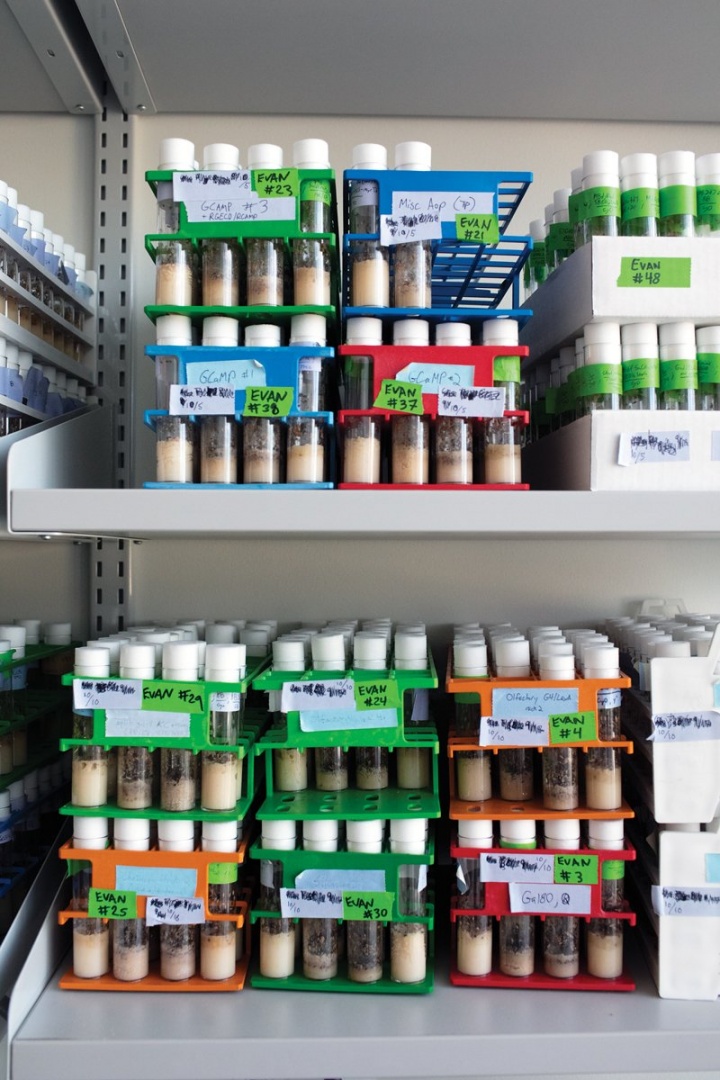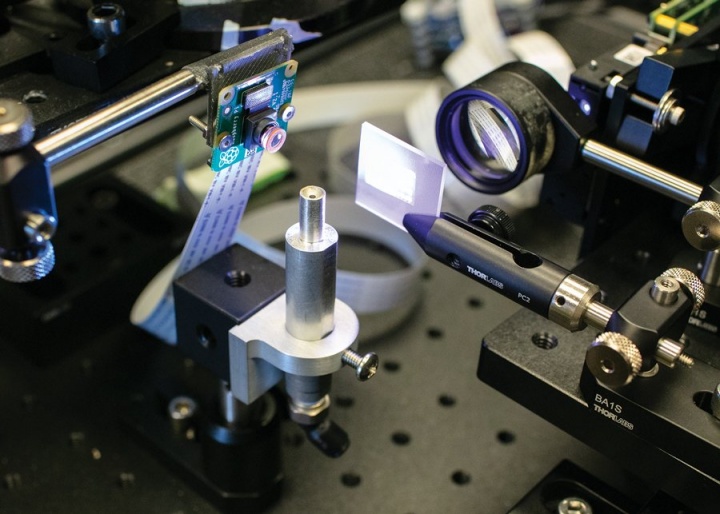University Professor Dr. Richard Axel ’67
is on a quest for knowledge across
multiple disciplines.
Columbia College | Columbia University in the City of New York
University Professor Dr. Richard Axel ’67
is on a quest for knowledge across
multiple disciplines.

Dr. Richard Axel ’67 in his Manhattanville office.
Photographs by Jörg Meyer
Dr. Richard Axel ’67 attributes the path of his Nobel-Prize-winning career, in part, to a Dutch mail van.
In the 1940s, biologist Nikolaas Tinbergen found that male stickleback fish would attack the sides of their tank at noon. That happened to be when the mail van, with its red bottom and white top — just like a rival male stickleback — would drive by. In the 1980s, Axel, a mid-career molecular biologist with a budding interest in innate behavior, learned of the anecdote in a journal article and read on, discovering other programmed behavior in the stickleback, including the fact that females who’d never seen a red male were attracted to them. Behavior, he knew, was controlled by the brain. “That was the final observation that drove me into neuroscience,” he says.
Axel, now a professor of biochemistry and co-director of Columbia’s Zuckerman Institute, has a knack for combining fields, like following the trail from molecular biology into neuroscience. Working with people from other areas has served him, and science, well. In 2004, he shared a Nobel Prize for work on the neuroscience of odor perception.
Axel’s self-narrative contains many contingencies and inflection points, and he credits various mentors with shaping him. “It was a combination of my passions and people who were extremely important in guiding a young boy,” he says. “My parents were great, but they were not educated. The idea of me becoming a scientist was not within their lexicon.”
When asked if he would have ended up where he is without various nudges, he deploys a sly mix of humor and humility. “No. Maybe I would own a kosher delicatessen. I would’ve enjoyed that.”
Distinguishing nature from nurture can be hard, but one gets the sense Axel would have been successful under many conditions — maybe even Nobel successful. “He’s a remarkable intellect across all fields,” says his close collaborator Larry Abbott Ph.D., co-director of Columbia’s Center for Theoretical Neuroscience and principal investigator at the Zuckerman Institute. “He knows everything to a first approximation. He knows art, he knows the theater, he knows novels and he can quote poetry at any moment.” Not to be dismissed: “He also has an incredible fund of jokes. So that makes him fun to be around, because he has so much in his head and sooner or later it comes out.”

Axel and research technician Julia Barasch ’17 in the lab at Columbia’s Zuckerman Institute.
Growing up in Crown Heights, Brooklyn, Axel started working at 11, delivering false teeth to dentists. One of his early nudges toward the life of an intellectual came in middle school. At the time he was keen on basketball, but his principal pushed him to attend Stuyvesant H.S., an establishment for those gifted academically but not necessarily athletically.
In one game, he faced an opponent who put his hand in front of Axel’s face and said, “What are you going to do, Einstein?” before scoring 54 points to Axel’s 2. (That player was Lew Alcindor, who now goes by Kareem Abdul-Jabbar.)
As a student in Manhattan, Axel fell in love with the culture, visiting the opera twice a week, studying at the New York Public Library, hanging out with artists in the Village. When Columbia offered him a full scholarship, he accepted in order to stay close to his family and to continue the big city experience. Without ignoring the arts, he focused more on his books, especially literature.
“I really feel Columbia shaped me,” he said during a recent visit to his lab. “It was during that period that my quest for knowledge was born, and they nourished it beautifully. It was a very exciting time, the ’60s. We were learning amidst turmoil. And, as there is now, there were real greats, Moses Hadas [GSAS’30], Jacques Barzun [CC 1927, GSAS’32], Lionel Trilling [CC 1925, GSAS’38], Meyer Shapiro [CC 1924, GSAS’35]. These were really great humanists.”
More happenstance: To support himself, Axel found a job washing glassware in a medical lab. The process by which DNA makes RNA, which then makes proteins, was being worked out, and it entranced the young Axel. “It was clear that all of the information necessary to create life over billions of years resided in the order of bases in DNA,” Axel says. “And now the question was how you decode that information to generate the variations in life. It was a spectacular problem and it was being torn apart by very elegant experiments.” His curiosity surpassed his facility with flasks, so he was fired and rehired as a research assistant. The laboratory head, Bernard Weinstein, fed his hunger, and Axel decided to pursue biology over literature.
Axel went off to medical school at Johns Hopkins, but he was no better with scalpels and stethoscopes than with beakers. At one point he sutured a surgeon’s finger to a patient. He writes in an autobiographical essay on the Nobel Prize website: “I was allowed to graduate medical school early with an M.D. if I promised never to practice medicine on live patients. I returned to Columbia as an intern in Pathology, where I kept this promise by performing autopsies. After a year in Pathology, I was asked by [the department chair] never to practice on dead patients.”

Axel’s team uses genetics to manipulate and observe neurons in the brains of flies, and there are thousands of different genotypes in the lab. The flies live in the vials with food at the bottom.
Axel returned to Columbia for a postdoctoral fellowship in molecular biology. Because he’d gone to medical school to avoid the draft — he calls himself a “yellow beret” — he owed the government two years of work and went to the National Institutes of Health, in Bethesda, Md., for a second postdoc. Finally, in 1974, he returned to Columbia once again, this time as a professor.
One of Axel’s early discoveries paid off handsomely. In the mid-1970s, researchers were developing recombinant DNA technology, the ability to move genes from one organism to another. Axel and two colleagues found a way to place a gene in a eukaryotic cell — one with a nucleus — and make sure that it succeeded in producing proteins. “That turned out to open up a whole new arena of both biology and biotechnology,” Axel says, allowing for innovative protein therapies and discoveries about the genetic basis of disease. “It was really exciting.” At the time people accused him of playing God for mixing distinct species, but recombinant DNA is now used regularly, with Axel’s patents netting the University close to a billion dollars.
Instead of endlessly generating scientific papers out of the discovery, Axel moved on, often led into new areas by his students and postdocs. He didn’t know anything about immunology when a young immunologist named Dan Littman joined his lab. They stumbled upon the gene for the receptor to which HIV binds, “an interesting observation of some importance,” Axel adds. A modest assessment, as that observation has led to the potential for new treatments for AIDS patients.
“He’s a remarkable intellect across all fields. He knows everything
to a first approximation. He knows art, he knows the theater,
he knows novels and he can quote poetry at any moment.”
In the 1980s, Axel began talking with University Professor and the Kavli Professor of Brain Science Eric Kandel, the neuroscientist who would win a Nobel Prize in 2000 for his work on memory. The two, bored in faculty meetings, would hold side discussions on biology. Axel wondered whether there was a place in neuroscience for a molecular geneticist. That’s when he came across the story of the Dutch mail van and the innate responses of those stickleback fish. “That led me to think that you are building a perceptual system through evolution,” he says, “and how do you build those? You build those with genes.” He made himself comfortable in yet another discipline, neuroscience.
Axel was fascinated by how brains can create rich representations of the world using just the activation of neurons. As a molecular geneticist entering neuroscience, he felt that the sense most amenable to his expertise was olfaction. How are we able to recognize such a wide variety of molecules that we identify as odorants? Somehow we can detect thousands or millions of distinct smells in the world. Axel figured such a skill would require receptors for many different odor molecules, and those receptors would require many genes.
In 1982, a “tenacious” researcher named Linda Buck joined his lab, Axel says. When he set his sights on olfaction, she began working with “thoughtfulness and intensity” to identify genes for odorant receptors. Buck worked on the problem for six years as they took lots of missteps, finding genes that met maybe one criterion but not others. “And then she came up with a very clever experimental design,” Axel says, “and very late one night she walked into my office and showed me a set of data that revealed the existence of an extremely large family of genes that exhibited the properties one would expect for odorant receptor genes. And the remarkable thing was there were a lot of them.”
They didn’t know quite how many at the time, but today the count stands at more than 1,000 mammalian genes for olfactory receptors. That’s the largest family of genes in a human genome of 25,000 genes.
“When we explored the data together,” Axel says, “I fell silent for an extremely long time. I was so impressed with the thoughtfulness of the experiment and the power of the result. At that moment my head was beginning to formulate models for the function of the olfactory system.” Dozens of potential experiments unfolded before his eyes. “I could see the next decades of our lives employing the genes as a very powerful entree into very complex perceptual problems,” he says. “And that’s where I stand today.” They published their discovery in 1991; 13 years later, once its impact had become clear, Buck and Axel were awarded a Nobel Prize.
The olfactory system has proven a potent muse for Axel. “What’s occupying me is how the brain accommodates the rich variability in the world, how meaning is imposed.” He notes how, for the French novelist Marcel Proust, “the smell of a madeleine brought forth seven volumes of Remembrances of Things Past.” Olfaction is also fascinating to him because smell is the most primal sense; it equips organisms to find food and mates, and to avoid predators.

Details of “the toy,” used to study fear in flies.
Evan Schaffer Ph.D. GSAS’11

A small camera (shown in green) records movies of the fly behavior while researchers present visual stimuli onto the small piece of glass.
Evan Schaffer Ph.D. GSAS’11
Signals from the olfactory bulb head to several other brain areas, including the amygdala, which triggers innate reactions to certain smells. Lately, Axel’s lab has been using a new experimental method called optogenetics, which allows scientists to make particular cells active or inactive by shining light on them. With this technique, Axel has shown that deactivating regions of a mouse’s amygdala prevents it from avoiding fox urine — usually a red-alert smell. But activate the regions, and even without exposing it to urine the mouse goes running. Together, the reactions demonstrate the amygdala is essential to processing innate odor responses.
The olfactory bulb also sends signals to the piriform cortex, an area of the brain that processes learned associations. This pathway especially interests Axel. “The really important questions are how you impose meaning on a particular representation in the brain,” he says.
“If I asked you to describe what the odor of an orange meant to you, and you had never seen an orange, it would be a very, very different perceptual event than if you had indeed experienced that odor when you cut an orange while you were sitting in an orange grove on the shore of the Mediterranean with a loving partner. And it’s all of these experiences that give a richness to perception that involve aspects of the brain about which we know rather little — memory, emotion, cognition.”
Answering big scientific questions requires careful experimentation, and on a tour of his lab, Axel asks one of his post-docs, Evan Schaffer Ph.D. GSAS’11, to demonstrate “the toy.” This turns out to be a device that holds a fruit fly to the surface of something resembling a track ball. It records the direction a fly crawls as it’s bombarded with sights or smells — “basically fly virtual reality,” Schaffer says. At the same time, a microscope called SCAPE, developed by Elizabeth Hillman Ph.D., a professor of biomedical engineering and radiology at Columbia and a principal investigator at the Zuckerman Institute, is used to detect the activity of all 10,000 neurons in a fly’s brain. Observing the fly as it tries to escape a heat source or approach pheromones might tell us something about how we react to pleasure and pain. “What is an emotional state?” Axel asks. “Anxious, afraid, hungry, aroused — what’s the representation of an emotional state in the brain?”
“What’s inspiring about working with him,” his colleague Abbott says, “other than that of course he’s a great scientist and all, is that he has tremendous drive to get to the bottom of the big questions.” Buck, who won the Nobel with him, agrees. “He is not content to add bricks to a standing structure of knowledge,” she says. “He wants to push the boundaries.”

Axel working with Evan Schaffer Ph.D. GSAS’11.
Meanwhile, Axel draws lab members from different fields and gives them room to roam. “He really lets people explore new ideas and chart their own course, once he is confident that they can do it,” Buck says.
Leslie Vosshal Ph.D. ’87, a former lab member who is now a professor at The Rockefeller University, says being in his lab was “like being in a circus. Everyone was attempting something improbable and death-defying.” Vanessa Ruta Ph.D., who was a neuroscience postdoc in Axel’s lab for five years before also becoming a professor at Rockefeller, says his appreciation of diverse people and perspectives “encouraged me to be a much braver and broader-thinking scientist.” That inclusive approach has helped Axel move into new areas. “I’ve been eclectic in my interests as I’ve moved around,” he says. “I did genetics, molecular biology, immunology, neuroscience. You can’t move facilely from one discipline to another in biology without having spectacular colleagues around to teach you. I had students as well as Columbia professors who afforded a rich environment for me to learn and collaborate.” Again he deflects credit to his surroundings: Nurture.
Axel still finds time to leave the lab and pursue his interests in art and culture. “I’m obsessed with opera,” he says. “I’m at the opera at least once a week in season. I listen to music. My son’s a creative photographer. I spend several hours a week in museums and galleries. My Nobel autobiography begins, ‘New York City is my world,’ and it is.”
“He’s an incredibly sociable person and he really takes advantage of living in the city as much as anyone I know,” Abbott says. “He’s a real product of the city.” He’s also a product of the school that engaged his interests in the humanities, that turned him on to biology and that has supported him for most of his career. As Abbott says, “He is Columbia, right?”
Matthew Hutson is a freelance science writer in New York City and the author of The 7 Laws of Magical Thinking.

Published three times a year by Columbia College for alumni, students, faculty, parents and friends.
Columbia Alumni Center
622 W. 113th St., MC 4530, 6th Fl.
New York, NY 10025
212-851-7852
cct@columbia.edu

Columbia Alumni Center
622 W. 113th St., MC 4530, 4th Fl.
New York, NY 10025
212-851-7488
ccalumni@columbia.edu